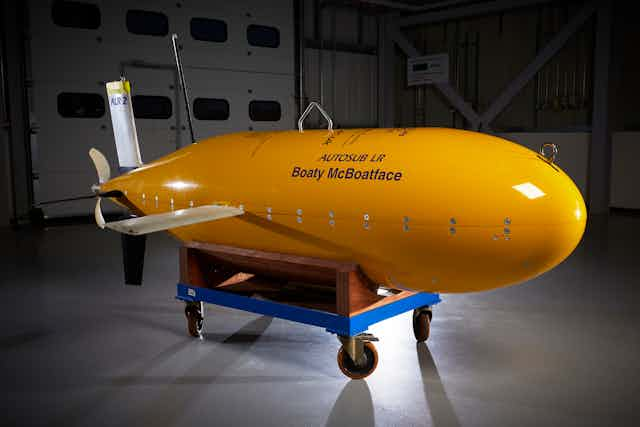The research submarine Boaty McBoatface is about to be used for the first time. Boaty is world-famous thanks to its name: the result of a joke entry to a naming contest that went viral, but few know what the sub will actually do. Well, I am currently lead scientist on RRS James Clark Ross, Boaty’s parent ship, which just set sail from Chile. Here’s what we want to find out.
Around the world, deeper ocean waters have been steadily warming over the past few decades, faster than we would expect simply through overall climate change. This suggests that global warming has triggered some sort of a change in deep sea circulation, which has sent extra heat into the lowest layers of the ocean. On its maiden voyage, Boaty will help us investigate why this is.
The process begins in the seas near the Antarctic coast. As they are blasted by freezing winds blowing off the continent’s vast ice sheet, the waters become cold and dense, and sink into the abyss. Those waters then spread northward to the rest of the globe in streams that flow along the ocean floor.
Along the way, these deep water streams encounter several submarine mountain ranges, the very peaks of which can appear above the surface as islands like South Georgia (where Ernest Shackleton famously sailed to after becoming stranded in Antarctica). When the streams run into these mountains they meander around and across them, forming highly turbulent rapids and waterfalls along the way – very much like rivers do on the Earth’s surface.

We don’t yet know what causes the recent deep ocean warming, but the available evidence suggests that these rapids and waterfalls are at the heart of the issue. Scientists believe that strengthening winds over the Southern Ocean have caused the deep water streams to speed up, and become more turbulent in the areas where they have to negotiate mountains and ridges. More turbulence means increasingly vigorous mixing of cold deep waters with warmer water from the upper ocean, leading to overall warming at the bottom of the ocean.
To test this hypothesis and identify how changing winds and deep ocean warming are linked, a team of UK and US scientists, including myself, has set off on a 52-day expedition to the Southern Ocean. We’ll focus on the Orkney Passage – a 3,000-metre deep, narrow gorge in a large submarine mountain range which about a quarter of all the deep water flowing northward from Antarctica squeezes through.
As water flows through the passage we’ll get detailed measurements of its speed, temperature and turbulence. We’ll use a combination of vertical profilers deployed from the ship, instruments moored to the ocean floor, and the autonomous underwater vehicle Autosub Long Range – widely known, of course, as Boaty McBoatface.
Boaty is a cutting-edge unmanned submarine that can perform missions that last several days, cover distances of hundreds of kilometres, and dive down to 6,000 metres. These subs mean scientists can access some of the most remote and hazardous environments in the ocean.
Boaty’s mission will be to ride along the deep-water stream as it finds its way through the Orkney Passage, measuring every meander, rapid and waterfall in much greater detail than is possible with mainstream oceanographic instrumentation. The data collected by Boaty will be key to unravelling how the deep water turbulence in the passage is regulated by changing winds.
Our ultimate goal is to learn enough about what happens when deep water streams hit submarine mountain ranges to represent these processes (for the first time) in the models used to predict how our climate will evolve over the 21st century – and beyond.

